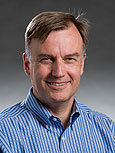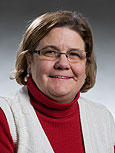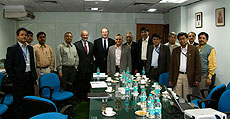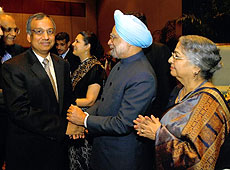|
Have a safe day!
Tuesday, Jan. 26
11 a.m.
Computing Techniques Seminar - FCC2A/2B
Speaker: Jack Lange, Northwestern University
Title: Architecting a Symbiotic Virtual Machine Monitor for Scalable High Performance Computing
2:30 p.m.
Particle Astrophysics Seminar - One West
Speaker: Amanda Weltman, University of Cape Town
Title: Dark Energy - And Where To Find It
3:30 p.m.
DIRECTOR'S COFFEE BREAK - 2nd Flr X-Over
Wednesday, Jan. 27
3:30 p.m.
DIRECTOR'S COFFEE BREAK - 2nd Flr X-Over
4 p.m.
Fermilab Colloquium -
One West
Speaker: Gino Segre, University of Pennsylvania
Title: A 1932 Meeting at Bohr's Institute:
The Birth of New Ideas in Physics
Click here for NALCAL,
a weekly calendar with links to additional information.
Upcoming conferences |
|
|
For information about H1N1, visit Fermilab's flu information site.
|
|
Tuesday, Jan. 26
- Breakfast: Bagel sandwich
- Chicken & rice soup
- Italian sausage w/peppers & onions
- Beef stroganoff
- Chicken lemon
- Peppered beef
- Assorted sliced pizza
- Chicken tostadas
Wilson Hall Cafe Menu
|
|
Wednesday, Jan. 27
Lunch
- Chicken & vegetable stir fry w/ cashew rice
- Orange almond cake
Thursday, Jan. 28
Dinner
- Closed
Chez Leon Menu
Call x3524 to make your reservation.
|
|
|
Strait joins LBNE as project manager
 |
| Jim Strait |
On Jan. 25 Fermilab physicist Jim Strait began a new job as project manager for the laboratory's Long Baseline Neutrino Experiment. Gina Rameika, who led the LBNE project initiation phase to establish Department of Energy mission need, or CD-0, will become LBNE's project scientist.
"The Long Baseline Neutrino Experiment will be a flagship of Fermilab physics at the Intensity Frontier," said Associate Director for Research Greg Bock. "Gina successfully led the extraordinary effort to reach CD-0. Now we are fortunate to have Jim Strait's experienced leadership as we begin the next tremendous push to reach CD-1."
Strait, who began his Fermilab career in 1985, led the US project to design and build advanced magnets and other accelerator components for CERN's Large Hadron Collider. He served as head of the Particle Physics Division from 2004 until 2008. Now he returns to Fermilab after spending a year and a half working with CERN physicists on LHC commissioning. He will guide the LBNE project through the various stages of the DOE Critical Decision review process.
"I am eager to get to work with the LBNE team on the formidable technical challenges ahead," Strait said. "It's a tough experiment, but neutrinos may hold the key to our very existence."
 |
| Gina Rameika |
Rameika will focus on working with the LBNE Science Collaboration to evaluate how various design and cost-cutting decisions would affect the scientific reach of the experiment.
"Having achieved CD-0, the amount of work before us has increased significantly," Rameika said. "Jim and I, together with the project engineer, will make sure that all the bases are covered."
-- Judith Jackson
|
US flexes its developing SRF muscles
US researchers recently proved their ability to process and test world-class superconducting radiofrequency, SRF, cavities.
In preparing two dressed, high-gradient nine-cell ILC-type cavities for use in the S1-global effort, a prototype at KEK of the International Linear Collider main linac, researchers had to climb multiple technical hurdles.
SRF cavities enable accelerators to increase particle beam energy levels while minimizing the use of electrical power by all but eliminating electrical resistance. Future experiments into the origins of the universe and nature of matter, including the proposed ILC and Project X, both of which Fermilab would like to host, will require advanced SRF technology.
The shipped cavities show the US is well on its way to meeting those technology needs.
The processing and assembly of the cavities depended heavily on the contribution of scientists and engineers across the globe, including at Argonne National Laboratory, Thomas Jefferson National Accelerator Facility, SLAC National Accelerator Laboratory, Cornell University, INFN and DESY.
Initial testing of the cavities involved dipping them in liquid helium and supplying a low-power RF source. Cavities that reached the needed accelerating field got sealed into a helium vessel and outfitted, or dressed, with auxiliary components necessary for high-power operation in an accelerator. These components include input couplers to feed RF power into the cavity and tuners to adjust the cavity's resonant frequency.
Read more
--Tona Kunz
|
Physicists' dreams and worries in era of the big collider
From New York Times, Jan. 25, 2010
A few dozen scientists got together in Los Angeles for the weekend recently to talk about their craziest hopes and dreams for the universe.
At least that was the idea.
"I want to set out the questions for the next nine decades," Maria Spiropulu said on the eve of the conference, called the Physics of the Universe Summit. She was hoping that the meeting, organized with the help of Joseph D. Lykken of the Fermi National Accelerator Laboratory and Gordon Kane of the University of Michigan, would replicate the success of a speech by the mathematician David Hilbert, who in 1900 laid out an agenda of 23 math questions to be solved in the 20th century.
Dr. Spiropulu is a professor at the California Institute of Technology and a senior scientist at CERN, outside Geneva. Next month, CERN's Large Hadron Collider, the most powerful particle accelerator ever built, will begin colliding protons and generating sparks of primordial fire in an effort to recreate conditions that ruled the universe in the first trillionth of a second of time.
Read more
|
Speculating about the universe as a quantum fluid
From Ars Technica, Jan. 25, 2010
he first thing that struck me about Hitoshi Murayama was that he certainly did not fit the stereotype of a Japanese presenter-he's relaxed, eloquent, and clearly very, very excited about his work. He is the head of a new research center in Japan called the Institute for the Physics and Mathematics of the Universe-a purview that allows him to study just about anything. But he's chosen to study everything; Murayama wants to know why there is, in fact, a universe.
Because the Physics@FOM audience comes from a range of backgrounds, Murayama's talk was light on details and strong on providing a flavor of the problem and inspiring the audience. And inspired I was, as he took us on a whirlwind tour of the known Universe, including dark matter and inflation. He wrapped up by going completely off the map with some of the ideas that he has had floating around for some time now.
Read more
|
|
|
Visit to India: Part I
 |
| Scientists and engineers during a visit to VECC. The fourth through seventh from the left are Shekhar Mishra, Pier Oddone, Dennis Kovar and Dr. R.K. Bhandari, director of VECC |
For the last 10 days, I visited our collaborators in India, met prospective new collaborators and altogether visited five Indian national laboratories. Our delegation consisted of myself; Dennis Kovar, the DOE Associate Director for High Energy Physics; and Shekhar Mishra, the Fermilab scientist who has been our ambassador and the main organizer of the collaboration with India. Jerry Blazey, NIU professor on leave to the DOE's Office of High Energy Physics, joined us for part of the visit. I also attended the meeting of FALC, the Funding Agencies for Large Colliders, which met in Mumbai on Jan. 17-18.
Indian institutions have been important participants in experimental programs throughout the history of Fermilab. In 2006 we added a major new collaboration for the development of superconducting linear accelerators, in particular for the development of technologies that are needed for Project X and for the ILC. Our immediate interest is in the development of high intensity proton accelerators, in particular, Project X. The construction of Project X will be greatly sped up if we can form a strong international collaboration for its construction, something that has not happened before in the construction of U.S. accelerators. Indian institutions are driven by their interest in developing high-intensity accelerators for neutron sources, for transmutation of radioactive waste and, someday, for driving thorium subcritical reactors that have multiple advantages for India, especially with the low availability of natural uranium resources within the country.
The first laboratory we visited was the Variable Energy Cyclotron Center (VECC) in Kolkata, a premier nuclear physics laboratory of the India Department of Atomic Energy (DAE.) Their main facility up to now has been a room-temperature variable energy cyclotron similar to the 88" cyclotron in Berkeley. This facility has been a workhorse for nuclear physics in India since 1980. The institute has now finished construction of an impressive superconducting cyclotron that is in the commissioning stages. VECC has expert groups in mechanical and cryogenic engineering who would be involved in the development of superconducting linacs. Their director, Dr. Bhandari, visited Fermilab recently in connection with the High Intensity Proton Workshop last year. He was a gracious host and very supportive of our collaboration; and we appreciated meetings and discussions with the scientists and engineers who would collaborate with us.
The second laboratory we visited was the Indira Ghandi Center for Atomic Research (IGCAR), which was established with a very sharp focus: the development of fast breeder reactors. The laboratory has 2,400 staff members and has impressive laboratories and facilities for all aspects of reactor design and development, starting with basic materials science. They have operated a fast breeder reactor, liquid sodium cooled, since 1985 and with that experience are now building a 500MW (electrical) fast breeder reactor on the site. The reactor vessel, an immense stainless steel-structure, was assembled on site and the reactor building is nearly complete. The present plan would start commissioning the reactor in 2011. IGCAR has not been involved in our collaboration but in the long term would be an important player in the development of thorium breeder reactors, including the ultimate dream of driving them in a subcritical mode using high-intensity proton accelerators.
Part II will come next week.
 |
| Shekhar Mishra stands with Manmohan Singh, the Indian prime minister, in Washington, D.C., in November. |
|
|